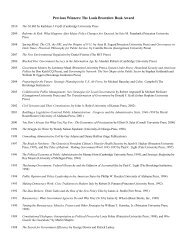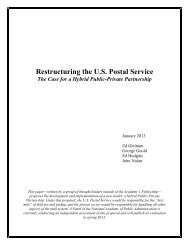High-Performance Partnerships - National Academy of Public ...
High-Performance Partnerships - National Academy of Public ...
High-Performance Partnerships - National Academy of Public ...
Create successful ePaper yourself
Turn your PDF publications into a flip-book with our unique Google optimized e-Paper software.
LEADERSHIP<br />
chapter five<br />
D espite the desire to use a methodical process to create them, cross-sector partnerships sometimes<br />
just happen. Other times, they do not despite seemingly favorable conditions. Success<br />
or failure is <strong>of</strong>ten due to the presence or absence <strong>of</strong> adequate leadership. When communities<br />
face crises, dynamic and visionary individuals can emerge to assemble parties that can make a difference.<br />
These champions—or leader/guiders—provide the vision, motivation, and incentives to<br />
create partnerships (<strong>National</strong> League <strong>of</strong> Cities, 2000).<br />
Beyond their role as champion, leaders organize<br />
the partnership and make it work. In this role as<br />
leader/facilitator, they provide overall direction<br />
and ensure that a sustainable management<br />
structure is in place. It is important to note that<br />
stable, effective partnerships share ownership <strong>of</strong><br />
the mission and outcomes, and diffuse leadership<br />
roles throughout the organization. No one<br />
individual is likely to exhibit every leadership<br />
characteristic needed to create and sustain a<br />
high-performance partnership. As a partnership<br />
evolves, the type <strong>of</strong> leadership also will evolve.<br />
The design lab participants identified five key<br />
components—the five “Cs”—<strong>of</strong> leadership:<br />
credibility, commitment, change agent, communications,<br />
and capability. The early credibility<br />
<strong>of</strong> the partnership is inextricably linked to the<br />
credibility <strong>of</strong> its leadership. Until the partnership<br />
can establish its own track record and sense<br />
<strong>of</strong> identity, the image <strong>of</strong> those associated with it<br />
is influential. Funders, other partners, and the<br />
broader community must believe that the<br />
endeavor is worth their investment and support.<br />
This perception hinges on the leadership’s<br />
reputation until the partnership can prove its<br />
competency.<br />
Commitment to the partnership’s vision and<br />
mission also is key. A motivational leader inculcates<br />
a partnership’s vision and values throughout<br />
the members, thus increasing the likelihood<br />
<strong>of</strong> success. It is absolutely critical that the partnership’s<br />
leaders “keep an eye on the prize.” All<br />
organizations, but especially high-performance<br />
ones, must affirm and reaffirm their mission,<br />
vision, and goals.<br />
Leaders must be able to get things done, especially<br />
in the early stages <strong>of</strong> collaboration. As such, they<br />
are agents <strong>of</strong> change. If the status quo worked<br />
well, there would be no need to create a new partnership.<br />
They must be able to identify changes<br />
and implement them quickly and effectively.<br />
A change agent’s effectiveness is dependent upon<br />
the ability to motivate stakeholders to share the<br />
partnership’s vision and understand the need for<br />
change. Thus, communications skills are a vital<br />
element. Clearly communicating the partnership’s<br />
purpose to internal and external audiences<br />
is essential to developing support for activities.<br />
The leader also must be able to deliver difficult<br />
messages, such as defending the need for further<br />
change or explaining results that fall below<br />
expectations. Delivering messages in an instructive<br />
manner is a clear sign <strong>of</strong> a capable leader.<br />
Talented leaders surround themselves with<br />
resourceful individuals and organizations. In<br />
addition, they must exhibit such resourcefulness<br />
and capability themselves. The ability to focus<br />
on outcomes and marshal support for them is<br />
especially important in the early stages.<br />
76 Powering the Future: <strong>High</strong>-<strong>Performance</strong> <strong>Partnerships</strong>









